第一章:集合体系结构
1.1 概述
- 集合是 Java 提供的一种容器,可以用来存储多个数据。集合的本质是用来
存储对象。
提醒
- 【问】:集合只能用来存储对象?为什么也可以存储基本数据类型?
- 【答】:在 JDK5 的时候,新增了一个特性:自动装箱和自动拆箱。换言之,向集合中添加基本类型数据的时候,会先转换为对应的包装类型对象,然后在进行存储。
- 集合和数组都是容器,它们之间的区别?
- ① 数组的长度是固定的,集合的长度是可变的。
- ② 数组中可以存储基本类型的数据,也可以存储对象;但是,集合中只能存储对象。
1.2 集合体系结构
- Java 中的集合主要分为两大类:
- ① Collection(单列集合):在添加数据的时候,一次只能添加一个数据,如:
脉动、康师傅、奥利奥等。 - ② Map(双列集合):在添加数据的时候,一次需要添加一对数据,如:
脉动:5元、康师傅:12元、奥利奥:8.5元。
- ① Collection(单列集合):在添加数据的时候,一次只能添加一个数据,如:
- Java 集合框架图,如下所示:

第二章:Collection 接口(⭐)
2.1 概述
- Collection 接口是 List、Set 接口的父接口,该接口中定义的方法既可以用于操作 List 集合,也可以用于操作 Set 集合。
提醒
JDK 不提供此接口的任何直接实现,而是提供更具体的子接口(如:List 、Set 等)实现。
提醒
- ① List 系列集合:添加的元素是有序、可重复、有索引。
- 有序:
存和取的顺序是一样的,如:存数据是张三、李四、王五,那么取数据也是张三、李四、王五;和之前学习的排序(从小到大或从大到小)没有任何关系。 - 可重复:集合存储的元素是可以重复的。
- 有索引:可以通过索引去获取集合中的元素。
- 有序:
- ② Set 系列集合:添加的元素是无序、不重复、无索引。
- 无序:
存和取的顺序有可能是不一样,如:存数据是张三、李四、王五,那么取数据可能是张三、王五、李四。 - 不重复:集合存储的元素是不可以重复的。
- 无索引:不可以通过索引去获取集合中的元素。
- 无序:
- 由于 JDK 5 增加了
泛型特性,使得 Java 集合可以记住容器中对象的数据类型。
java
public interface Collection<E> extends Iterable<E> {
...
}1
2
3
2
3
2.2 常用 API
2.2.1 添加元素
- 添加元素对象到当前集合中:
java
boolean add(E e);1
- 添加另一个集合中的所有元素到当前集合中:
java
boolean addAll(Collection<? extends E> c);1
提醒
- ① 当我们向 List 系列集合添加元素的时候,方法永远返回 true ,因为 List 系列集合是允许元素重复的。
- ② 当我们向 Set 系列集合添加元素的时候,如果要添加的元素在集合中不存在,方法返回 true ,表示添加成功;如果要添加的元素在集合中已经存在,方法返回 false,表示添加失败,因为 Set 系列集合是不允许元素重复的。
- ③ 在实际开发中,我们通常不会关心
add()方法或addAll()方法的返回值。
- 示例:
java
package com.github.collecton;
import java.util.ArrayList;
import java.util.Collection;
public class Test {
public static void main(String[] args) {
// 创建集合
Collection<Integer> coll = new ArrayList<>();
// 添加元素
coll.add(1);
coll.add(2);
coll.add(3);
coll.add(4);
coll.add(5);
// 打印集合中的元素
System.out.println(coll); // [1, 2, 3, 4, 5]
}
}1
2
3
4
5
6
7
8
9
10
11
12
13
14
15
16
17
18
19
2
3
4
5
6
7
8
9
10
11
12
13
14
15
16
17
18
19
- 示例:
java
package com.github.collecton;
import java.util.ArrayList;
import java.util.Collection;
import java.util.List;
public class Test {
public static void main(String[] args) {
// 创建另一个集合
List<Integer> list = List.of(1, 2, 3, 4, 5);
// 创建集合
Collection<Integer> coll = new ArrayList<>();
// 给集合添加元素
coll.add(11);
coll.add(22);
coll.add(33);
// 添加另一个集合中的所有元素到本集合中
coll.addAll(list);
// 打印集合中的元素
System.out.println(coll); // [11, 22, 33, 1, 2, 3, 4, 5]
}
}1
2
3
4
5
6
7
8
9
10
11
12
13
14
15
16
17
18
19
20
21
22
2
3
4
5
6
7
8
9
10
11
12
13
14
15
16
17
18
19
20
21
22
2.2.2 删除元素
- 从当前集合中删除第一个和 obj 对象匹配(调用 equals() 方法)的元素:
java
boolean remove(Object o);1
- 从当前集合中删除所有与 c 集合中相同的元素,即:求差集:
java
boolean removeAll(Collection<?> c);1
- 删除满足指定条件的集合中所有元素jdk8+:
java
default boolean removeIf(Predicate<? super E> filter) {
Objects.requireNonNull(filter);
boolean removed = false;
final Iterator<E> each = iterator();
while (each.hasNext()) {
if (filter.test(each.next())) {
each.remove();
removed = true;
}
}
return removed;
}1
2
3
4
5
6
7
8
9
10
11
12
2
3
4
5
6
7
8
9
10
11
12
- 示例:
java
package com.github.collecton;
import java.util.ArrayList;
import java.util.Collection;
public class Test {
public static void main(String[] args) {
Collection<String> c1 = new ArrayList<>();
c1.add("aa");
c1.add("bb");
c1.add("cc");
System.out.println("c1 = " + c1); // c1 = [aa, bb, cc]
// 删除
c1.remove("cc");
System.out.println("c1 = " + c1); // c1 = [aa, bb]
}
}1
2
3
4
5
6
7
8
9
10
11
12
13
14
15
16
17
18
2
3
4
5
6
7
8
9
10
11
12
13
14
15
16
17
18
- 示例:
java
package com.github.collecton;
import java.util.ArrayList;
import java.util.Collection;
public class Test {
public static void main(String[] args) {
Collection<String> c1 = new ArrayList<>();
c1.add("aa");
c1.add("bb");
c1.add("cc");
Collection<String> c2 = new ArrayList<>();
c2.add("ee");
c2.add("ff");
c1.addAll(c2);
System.out.println("c1 = " + c1); // c1 = [aa, bb, cc, ee, ff]
// 求差集
c1.removeAll(c2);
System.out.println("c1 = " + c1); // c1 = [aa, bb, cc]
}
}1
2
3
4
5
6
7
8
9
10
11
12
13
14
15
16
17
18
19
20
21
22
23
24
25
26
27
2
3
4
5
6
7
8
9
10
11
12
13
14
15
16
17
18
19
20
21
22
23
24
25
26
27
- 示例:
java
package com.github.collecton;
import java.util.ArrayList;
import java.util.Collection;
public class Test {
public static void main(String[] args) {
Collection<Integer> c1 = new ArrayList<>();
c1.add(1);
c1.add(2);
c1.add(3);
c1.add(4);
c1.add(5);
System.out.println("c1 = " + c1); // c1 = [1, 2, 3, 4, 5]
// 从集合中删除所有偶数
c1.removeIf(x -> x % 2 == 0);
System.out.println("c1 = " + c1); // c1 = [1, 3, 5]
}
}1
2
3
4
5
6
7
8
9
10
11
12
13
14
15
16
17
18
19
20
21
22
23
2
3
4
5
6
7
8
9
10
11
12
13
14
15
16
17
18
19
20
21
22
23
2.2.3 清空集合
- 清空集合,即:将集合中的所有元素删除:
java
void clear();1
- 示例:
java
package com.github.collecton;
import java.util.ArrayList;
import java.util.Collection;
public class Test {
public static void main(String[] args) {
Collection<String> c1 = new ArrayList<>();
c1.add("aa");
c1.add("bb");
c1.add("cc");
System.out.println("c1 = " + c1); // c1 = [aa, bb, cc]
// 清空集合
c1.clear();
System.out.println("c1 = " + c1); // c1 = []
}
}1
2
3
4
5
6
7
8
9
10
11
12
13
14
15
16
17
18
19
20
21
2
3
4
5
6
7
8
9
10
11
12
13
14
15
16
17
18
19
20
21
2.2.4 判断
- 判断当前集合是否是空集合(没有任何元素):
java
boolean isEmpty();1
- 判断当前集合是否包含指定的元素(底层会调用 o 对象的 equals() 方法):
java
boolean contains(Object o);1
- 判断 c 集合中的元素是否都在当前集合中存在,即:c 集合是否是当前集合的子集:
java
boolean containsAll(Collection<?> c);1
- 示例:
java
package com.github.collecton;
import java.util.ArrayList;
import java.util.Collection;
public class Test {
public static void main(String[] args) {
Collection<Integer> c1 = new ArrayList<>();
c1.add(1);
c1.add(2);
c1.add(3);
c1.add(4);
c1.add(5);
System.out.println(c1.isEmpty()); // false
Collection<Integer> c2 = new ArrayList<>();
System.out.println(c2.isEmpty()); // true
}
}1
2
3
4
5
6
7
8
9
10
11
12
13
14
15
16
17
18
19
20
21
22
2
3
4
5
6
7
8
9
10
11
12
13
14
15
16
17
18
19
20
21
22
- 示例:
java
package com.github.collecton;
import java.util.ArrayList;
import java.util.Collection;
public class Test {
public static void main(String[] args) {
Collection<String> c1 = new ArrayList<>();
c1.add("aa");
c1.add("bb");
c1.add("cc");
c1.add("dd");
System.out.println("c1 = " + c1.contains("aa")); // c1 = true
System.out.println("c1 = " + c1.contains("aaa")); // c1 = false
}
}1
2
3
4
5
6
7
8
9
10
11
12
13
14
15
16
17
2
3
4
5
6
7
8
9
10
11
12
13
14
15
16
17
- 示例:
java
package com.github.collecton;
import java.util.ArrayList;
import java.util.Collection;
public class Test {
public static void main(String[] args) {
Collection<String> c1 = new ArrayList<>();
c1.add("aa");
c1.add("bb");
c1.add("cc");
c1.add("dd");
Collection<String> c2 = new ArrayList<>();
c2.add("aa");
c2.add("bb");
c2.add("ee");
// c1.containsAll(c2) = false
System.out.println("c1.containsAll(c2) = " + c1.containsAll(c2));
Collection<String> c3 = new ArrayList<>();
c3.add("aa");
c3.add("bb");
// c1.containsAll(c3) = true
System.out.println("c1.containsAll(c3) = " + c1.containsAll(c3));
}
}1
2
3
4
5
6
7
8
9
10
11
12
13
14
15
16
17
18
19
20
21
22
23
24
25
26
27
28
29
2
3
4
5
6
7
8
9
10
11
12
13
14
15
16
17
18
19
20
21
22
23
24
25
26
27
28
29
2.2.5 获取集合中元素的个数
- 获取当前集合中实际存储的元素个数:
java
int size();1
- 示例:
java
package com.github.collecton;
import java.util.ArrayList;
import java.util.Collection;
public class Test {
public static void main(String[] args) {
Collection<String> c1 = new ArrayList<>();
c1.add("aa");
c1.add("bb");
c1.add("cc");
c1.add("dd");
System.out.println("c1.size() = " + c1.size()); // c1.size() = 4
c1.clear();
System.out.println("c1.size() = " + c1.size()); // c1.size() = 0
}
}1
2
3
4
5
6
7
8
9
10
11
12
13
14
15
16
17
18
19
20
2
3
4
5
6
7
8
9
10
11
12
13
14
15
16
17
18
19
20
2.2.6 交集
- 当前集合仅保留与 c 集合中的元素相同的元素,即当前集合中仅保留两个集合的交集:
java
boolean retainAll(Collection<?> c);1
- 示例:
java
package com.github.collecton;
import java.util.ArrayList;
import java.util.Collection;
public class Test {
public static void main(String[] args) {
Collection<String> c1 = new ArrayList<>();
c1.add("aa");
c1.add("bb");
c1.add("cc");
c1.add("dd");
System.out.println("c1 = " + c1); // c1 = [aa, bb, cc, dd]
Collection<String> c2 = new ArrayList<>();
c2.add("bb");
System.out.println("c2 = " + c2); // c2 = [bb]
c1.retainAll(c2);
System.out.println("c1 = " + c1); // c1 = [bb]
}
}1
2
3
4
5
6
7
8
9
10
11
12
13
14
15
16
17
18
19
20
21
22
23
24
25
2
3
4
5
6
7
8
9
10
11
12
13
14
15
16
17
18
19
20
21
22
23
24
25
2.2.7 转数组
- 将当前集合中的所有元素转换为 Object 数组:
java
Object[] toArray();1
- 将当前集合中的所有元素转换为对应元素类型的数组(需要自己传递数组的长度):
java
<T> T[] toArray(T[] a);1
- 将当前集合中的所有元素转换为对应元素类型的数组(推荐,jdk8+):
java
default <T> T[] toArray(IntFunction<T[]> generator) {
return toArray(generator.apply(0));
}1
2
3
2
3
- 示例:
java
package com.github.collecton;
import java.util.ArrayList;
import java.util.Arrays;
import java.util.Collection;
public class Test {
public static void main(String[] args) {
Collection<String> c1 = new ArrayList<>();
c1.add("aa");
c1.add("bb");
c1.add("cc");
c1.add("dd");
// 将集合中的所有元素转换为 Object 数组
Object[] arr = c1.toArray();
System.out.println(Arrays.toString(arr)); // [aa, bb, cc, dd]
}
}1
2
3
4
5
6
7
8
9
10
11
12
13
14
15
16
17
18
19
20
2
3
4
5
6
7
8
9
10
11
12
13
14
15
16
17
18
19
20
- 示例:
java
package com.github.collecton;
import java.util.ArrayList;
import java.util.Arrays;
import java.util.Collection;
public class Test {
public static void main(String[] args) {
Collection<String> c1 = new ArrayList<>();
c1.add("aa");
c1.add("bb");
c1.add("cc");
c1.add("dd");
// 将集合中的所有元素转换为 String 数组
String[] arr = c1.toArray(new String[c1.size()]);
System.out.println(Arrays.toString(arr)); // [aa, bb, cc, dd]
}
}1
2
3
4
5
6
7
8
9
10
11
12
13
14
15
16
17
18
19
20
2
3
4
5
6
7
8
9
10
11
12
13
14
15
16
17
18
19
20
- 示例:
java
package com.github.collecton;
import java.util.ArrayList;
import java.util.Arrays;
import java.util.Collection;
public class Test {
public static void main(String[] args) {
Collection<String> c1 = new ArrayList<>();
c1.add("aa");
c1.add("bb");
c1.add("cc");
c1.add("dd");
c1.add("ee");
// 将集合中的所有元素转换为 String 数组
String[] arr = c1.toArray(String[]::new);
System.out.println(Arrays.toString(arr)); // [aa, bb, cc, dd, ee]
}
}1
2
3
4
5
6
7
8
9
10
11
12
13
14
15
16
17
18
19
20
21
2
3
4
5
6
7
8
9
10
11
12
13
14
15
16
17
18
19
20
21
2.3 遍历方式
2.3.1 概述
- Collection 集合是没有普通的 for 循环遍历,因为 Collection 集合是单列集合的顶层接口,其子接口 Set 是不可以通过索引来获取元素的。
- 为了程序的通用性,Collection 集合提供了三种遍历方式:
- ① 迭代器遍历。
- ② 增强 for 遍历。
- ③ Lambda 表达式遍历。
2.3.2 迭代器遍历
2.3.2.1 概述
- 我们可以通过
迭代器对象,将集合中的元素依次获取出来,如下所示:

2.3.2.2 Iterator 接口
- Iterator 接口也是 Java 集合中的一员,但是它和 Collection 接口以及 Map 接口有所不同:
- Collection 接口和 Map 接口主要用来存储元素。
- Iterator 接口主要用来迭代访问,即:遍历 Collection 集合或 Map 集合中的元素。
注意
所谓的迭代器,就是实现 Iterator 接口的对象!!!
- Collection 接口获取迭代器:
| 方法 | 描述 |
|---|---|
Iterator<E> iterator(); | 返回迭代器对象(创建指针),默认指向集合索引 0 的位置 |
- Iterator 接口的常用方法:
| 方法 | 描述 |
|---|---|
boolean hasNext(); | 判断当前位置是否有元素,如果有,返回 true;如果没有,返回 false |
E next(); | 获取当前位置上的元素,并将迭代器对象移动到下一个位置(移动指针) |
- 迭代器的内存示意图,如下所示:

- 示例:
java
package com.github.collection;
import java.util.ArrayList;
import java.util.Collection;
import java.util.Iterator;
public class Test {
public static void main(String[] args) {
// 创建集合对象
Collection<String> col = new ArrayList<>();
// 向集合中添加元素
col.add("aa");
col.add("bb");
col.add("cc");
col.add("dd");
// 获取迭代器对象,默认指向集合的 0 索引处
Iterator<String> iterator = col.iterator();
// 利用循环不断地去获取集合中的每一个元素
while (iterator.hasNext()) {
String next = iterator.next();
System.out.println("next = " + next);
}
}
}1
2
3
4
5
6
7
8
9
10
11
12
13
14
15
16
17
18
19
20
21
22
23
24
2
3
4
5
6
7
8
9
10
11
12
13
14
15
16
17
18
19
20
21
22
23
24
- 示例:
java
package com.github.collection;
import java.util.ArrayList;
import java.util.Collection;
import java.util.Iterator;
public class Test {
public static void main(String[] args) {
// 创建集合对象
Collection<String> col = new ArrayList<>();
// 向集合中添加元素
col.add("aa");
col.add("bb");
col.add("cc");
col.add("dd");
// 使用 for 循环来改写 while 循环
for (Iterator<String> iterator = col.iterator(); iterator.hasNext(); ) {
String next = iterator.next();
System.out.println("next = " + next);
}
}
}1
2
3
4
5
6
7
8
9
10
11
12
13
14
15
16
17
18
19
20
21
22
2
3
4
5
6
7
8
9
10
11
12
13
14
15
16
17
18
19
20
21
22
- 示例:
java
package com.github.collection;
public class Student {
private final String name;
private final Integer age;
public Student(String name, Integer age) {
this.name = name;
this.age = age;
}
@Override
public String toString() {
return "Student{" + "name='" + name + '\'' + ", age=" + age + '}';
}
}1
2
3
4
5
6
7
8
9
10
11
12
13
14
15
16
17
18
2
3
4
5
6
7
8
9
10
11
12
13
14
15
16
17
18
java
package com.github.collection;
import java.util.ArrayList;
import java.util.Collection;
import java.util.Iterator;
public class Test {
public static void main(String[] args) {
// 创建集合
Collection<Student> collection = new ArrayList<>();
// 给集合添加元素
collection.add(new Student("张三", 11));
collection.add(new Student("李四", 59));
collection.add(new Student("王五", 19));
collection.add(new Student("赵六", 42));
collection.add(new Student("田七", 8));
collection.add(new Student("王八", 2));
// 遍历集合
Iterator<Student> iterator = collection.iterator();
while (iterator.hasNext()){
Student next = iterator.next();
System.out.println(next);
}
}
}1
2
3
4
5
6
7
8
9
10
11
12
13
14
15
16
17
18
19
20
21
22
23
24
25
2
3
4
5
6
7
8
9
10
11
12
13
14
15
16
17
18
19
20
21
22
23
24
25
txt
Student{name='张三', age=11}
Student{name='李四', age=59}
Student{name='王五', age=19}
Student{name='赵六', age=42}
Student{name='田七', age=8}
Student{name='王八', age=2}1
2
3
4
5
6
2
3
4
5
6
2.3.2.3 迭代器的实现原理
- 在 Collection 接口中提供了获取 Iterator 接口的方法:
java
public interface Collection<E> extends Iterable<E> {
Iterator<E> iterator();
...
}1
2
3
4
5
6
2
3
4
5
6
- 实现 Collection 接口或子接口的实现类都必须实现该方法,以 ArrayList 为例:
java
public class ArrayList<E> extends AbstractList<E>
implements List<E>, RandomAccess, Cloneable, java.io.Serializable {
public Iterator<E> iterator() {
return new Itr();
}
private class Itr implements Iterator<E> {
int cursor; // index of next element to return
int lastRet = -1; // index of last element returned; -1 if no such
int expectedModCount = modCount;
// prevent creating a synthetic constructor
Itr() {}
public boolean hasNext() {
return cursor != size;
}
@SuppressWarnings("unchecked")
public E next() {
checkForComodification();
int i = cursor;
if (i >= size)
throw new NoSuchElementException();
Object[] elementData = ArrayList.this.elementData;
if (i >= elementData.length)
throw new ConcurrentModificationException();
cursor = i + 1;
return (E) elementData[lastRet = i];
}
public void remove() {
if (lastRet < 0)
throw new IllegalStateException();
checkForComodification();
try {
ArrayList.this.remove(lastRet);
cursor = lastRet;
lastRet = -1;
expectedModCount = modCount;
} catch (IndexOutOfBoundsException ex) {
throw new ConcurrentModificationException();
}
}
@Override
public void forEachRemaining(Consumer<? super E> action) {
Objects.requireNonNull(action);
final int size = ArrayList.this.size;
int i = cursor;
if (i < size) {
final Object[] es = elementData;
if (i >= es.length)
throw new ConcurrentModificationException();
for (; i < size && modCount == expectedModCount; i++)
action.accept(elementAt(es, i));
// update once at end to reduce heap write traffic
cursor = i;
lastRet = i - 1;
checkForComodification();
}
}
final void checkForComodification() {
if (modCount != expectedModCount)
throw new ConcurrentModificationException();
}
}
...
}1
2
3
4
5
6
7
8
9
10
11
12
13
14
15
16
17
18
19
20
21
22
23
24
25
26
27
28
29
30
31
32
33
34
35
36
37
38
39
40
41
42
43
44
45
46
47
48
49
50
51
52
53
54
55
56
57
58
59
60
61
62
63
64
65
66
67
68
69
70
71
72
73
2
3
4
5
6
7
8
9
10
11
12
13
14
15
16
17
18
19
20
21
22
23
24
25
26
27
28
29
30
31
32
33
34
35
36
37
38
39
40
41
42
43
44
45
46
47
48
49
50
51
52
53
54
55
56
57
58
59
60
61
62
63
64
65
66
67
68
69
70
71
72
73
2.3.2.4 迭代器的细节
2.3.2.4.1 NoSuchElementException 异常
- 当迭代器的指针已经指向了最后没有元素的位置,如果还强行调用 next() 方法,方法内部将会抛出 java.util.NoSuchElementException 异常,如下所示:
- 示例:
java
package com.github.collection;
import java.util.ArrayList;
import java.util.Collection;
import java.util.Iterator;
public class Test {
public static void main(String[] args) {
// 创建集合对象
Collection<String> col = new ArrayList<>();
// 向集合中添加元素
col.add("aa");
col.add("bb");
col.add("cc");
col.add("dd");
// 获取迭代器对象,默认指向集合的 0 索引处
Iterator<String> iterator = col.iterator();
// 利用循环不断地去获取集合中的每一个元素
while (iterator.hasNext()) {
String next = iterator.next();
System.out.println("next = " + next);
}
// ❌ 错误:会抛出 java.util.NoSuchElementException 异常
String next = iterator.next();
System.out.println("next = " + next);
}
}1
2
3
4
5
6
7
8
9
10
11
12
13
14
15
16
17
18
19
20
21
22
23
24
25
26
27
28
2
3
4
5
6
7
8
9
10
11
12
13
14
15
16
17
18
19
20
21
22
23
24
25
26
27
28
2.3.2.4.2 迭代器指针不会复位
- 当迭代器遍历完毕之后,指针不会复位。换言之,如果还想使用迭代器遍历,需要获取一个新的迭代器。
提醒
推荐使用 for 循环来代替 while 循环,因为 for 循环对于初始化变量有作用域!!!
- 示例:
java
package com.github.collection;
import java.util.ArrayList;
import java.util.Collection;
import java.util.Iterator;
public class Test {
public static void main(String[] args) {
// 创建集合对象
Collection<String> col = new ArrayList<>();
// 向集合中添加元素
col.add("aa");
col.add("bb");
col.add("cc");
col.add("dd");
// 获取迭代器对象,默认指向集合的 0 索引处
Iterator<String> iterator = col.iterator();
// 利用循环不断地去获取集合中的每一个元素
while (iterator.hasNext()) {
String next = iterator.next();
System.out.println("next = " + next);
}
// 获取一个新的迭代器对象
iterator = col.iterator();
// 利用循环不断地去获取集合中的每一个元素
while (iterator.hasNext()) {
String next = iterator.next();
System.out.println("next = " + next);
}
}
}1
2
3
4
5
6
7
8
9
10
11
12
13
14
15
16
17
18
19
20
21
22
23
24
25
26
27
28
29
30
31
32
2
3
4
5
6
7
8
9
10
11
12
13
14
15
16
17
18
19
20
21
22
23
24
25
26
27
28
29
30
31
32
- 示例:
java
package com.github.collection;
import java.util.ArrayList;
import java.util.Collection;
import java.util.Iterator;
public class Test {
public static void main(String[] args) {
// 创建集合对象
Collection<String> col = new ArrayList<>();
// 向集合中添加元素
col.add("aa");
col.add("bb");
col.add("cc");
col.add("dd");
// 使用 for 循环来改写 while 循环
for (Iterator<String> iterator = col.iterator(); iterator.hasNext(); ) {
String next = iterator.next();
System.out.println("next = " + next);
}
// 使用 for 循环来改写 while 循环
for (Iterator<String> iterator = col.iterator(); iterator.hasNext(); ) {
String next = iterator.next();
System.out.println("next = " + next);
}
}
}1
2
3
4
5
6
7
8
9
10
11
12
13
14
15
16
17
18
19
20
21
22
23
24
25
26
27
2
3
4
5
6
7
8
9
10
11
12
13
14
15
16
17
18
19
20
21
22
23
24
25
26
27
2.3.2.4.3 循环中只能使用一次 next 方法
- next 方法的作用,如下所示:
- ① 获取元素。
- ② 移动指针。
- 如果在循环中调用了两次 next 方法,将会使得指针移动两次,可能会导致方法抛出 java.util.NoSuchElementException 异常。
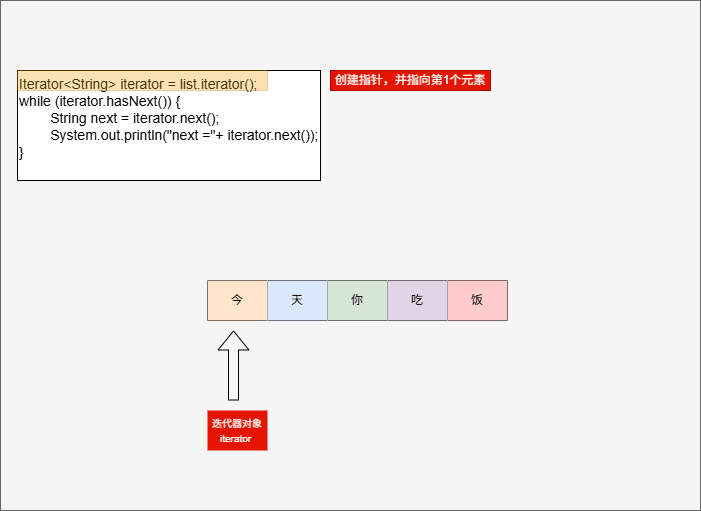
- 示例:
java
package com.github.collection;
import java.util.ArrayList;
import java.util.Collection;
import java.util.Iterator;
public class Test {
public static void main(String[] args) {
// 创建集合对象
Collection<String> col = new ArrayList<>();
// 向集合中添加元素
col.add("aa");
col.add("bb");
col.add("cc");
col.add("dd");
col.add("ee");
// 遍历集合中的元素
Iterator<String> iterator = col.iterator();
while (iterator.hasNext()) {
String next = iterator.next();
System.out.println(next);
// ❌ 错误:会抛出 java.util.NoSuchElementException 异常
next = iterator.next();
System.out.println(next);
}
}
}1
2
3
4
5
6
7
8
9
10
11
12
13
14
15
16
17
18
19
20
21
22
23
24
25
26
27
2
3
4
5
6
7
8
9
10
11
12
13
14
15
16
17
18
19
20
21
22
23
24
25
26
27
2.3.2.4.4 使用 Iterator 接口的删除方法
- Iterator 接口提供了删除的方法:
java
default void remove() {
throw new UnsupportedOperationException("remove");
}1
2
3
2
3
- 其实现类中实现了该方法,如下所示:
java
public class ArrayList<E> extends AbstractList<E>
implements List<E>, RandomAccess, Cloneable, java.io.Serializable {
public Iterator<E> iterator() {
return new Itr();
}
private class Itr implements Iterator<E> {
int cursor; // index of next element to return
int lastRet = -1; // index of last element returned; -1 if no such
int expectedModCount = modCount;
// prevent creating a synthetic constructor
Itr() {}
public boolean hasNext() {
return cursor != size;
}
@SuppressWarnings("unchecked")
public E next() {
checkForComodification();
int i = cursor;
if (i >= size)
throw new NoSuchElementException();
Object[] elementData = ArrayList.this.elementData;
if (i >= elementData.length)
throw new ConcurrentModificationException();
cursor = i + 1;
return (E) elementData[lastRet = i];
}
public void remove() {
if (lastRet < 0)
throw new IllegalStateException();
checkForComodification();
1
2
3
4
5
6
7
8
9
10
11
12
13
14
15
16
17
18
19
20
21
22
23
24
25
26
27
28
29
30
31
32
33
34
35
36
37
38
39
40
41
42
43
44
45
46
47
48
49
50
51
52
53
54
55
56
57
58
59
60
61
62
63
64
65
66
67
68
69
70
71
72
73
2
3
4
5
6
7
8
9
10
11
12
13
14
15
16
17
18
19
20
21
22
23
24
25
26
27
28
29
30
31
32
33
34
35
36
37
38
39
40
41
42
43
44
45
46
47
48
49
50
51
52
53
54
55
56
57
58
59
60
61
62
63
64
65
66
67
68
69
70
71
72
73
注意
- ① 在使用迭代器遍历集合元素的时候,如果调用 Collection 的 remove(xxx) 方法,将会抛出 java.util.ConcurrentModificationException 异常或出现其他不确定的行为。
- ② 在使用迭代器遍历集合元素的时候,如果要删除元素,使用迭代器的 remove() 方法。
- 示例:
java
package com.github.collection;
import java.util.ArrayList;
import java.util.Collection;
import java.util.Iterator;
public class Test {
public static void main(String[] args) {
// 创建集合对象
Collection<String> col = new ArrayList<>();
// 向集合中添加元素
col.add("aa");
col.add("bb");
col.add("cc");
col.add("dd");
col.add("ee");
// 遍历集合中的元素
Iterator<String> iterator = col.iterator();
while (iterator.hasNext()) {
String next = iterator.next();
if (next.equals("aa")) {
// ❌ 错误:会抛出 java.util.ConcurrentModificationException 异常
col.remove("aa");
} else {
System.out.println(next);
}
}
}
}1
2
3
4
5
6
7
8
9
10
11
12
13
14
15
16
17
18
19
20
21
22
23
24
25
26
27
28
29
2
3
4
5
6
7
8
9
10
11
12
13
14
15
16
17
18
19
20
21
22
23
24
25
26
27
28
29
- 示例:
java
package com.github.collection;
import java.util.ArrayList;
import java.util.Collection;
import java.util.Iterator;
public class Test {
public static void main(String[] args) {
// 创建集合对象
Collection<String> col = new ArrayList<>();
// 向集合中添加元素
col.add("aa");
col.add("bb");
col.add("cc");
col.add("dd");
col.add("ee");
// 遍历集合中的元素
Iterator<String> iterator = col.iterator();
while (iterator.hasNext()) {
String next = iterator.next();
if (next.equals("aa")) {
// ✅ 使用了 iterator 的 remove 方法
iterator.remove();
} else {
System.out.println(next);
}
}
}
}1
2
3
4
5
6
7
8
9
10
11
12
13
14
15
16
17
18
19
20
21
22
23
24
25
26
27
28
29
2
3
4
5
6
7
8
9
10
11
12
13
14
15
16
17
18
19
20
21
22
23
24
25
26
27
28
29
2.3.3 增强 for 遍历
2.3.3.1 概述
- 在 JDK1.4 之前,Collection 接口的源码,如下所示:
java
package java.util;
public interface Collection {
Iterator iterator();
// 其余略
}1
2
3
4
5
6
7
8
9
2
3
4
5
6
7
8
9
- 那么,我们遍历集合都需要使用迭代器的方式来遍历。但是,Java 官方认为这种方式太繁琐了,于是在 JDK1.5 之后增加了 Iterable 接口,如下所示:
java
package java.lang;
public interface Iterable<T> {
Iterator<T> iterator();
// 其余略
}1
2
3
4
5
6
7
8
9
2
3
4
5
6
7
8
9
- 并且,Collection 接口继承了 Iterable 接口,如下所示:
java
package java.util;
public interface Collection<E> extends Iterable<E> {
Iterator iterator();
// 其余略
}1
2
3
4
5
6
7
8
9
2
3
4
5
6
7
8
9
- 我们从 Iterable 接口源码的注释中,可以看到这样的信息,如下所示:
java
package java.lang;
/**
* Implementing this interface allows an object to be the target of the enhanced
* 实现此接口允许对象成为 enhanced for 语句(有时称为“for-each loop”语句)的目标
*/
public interface Iterable<T> {
Iterator<T> iterator();
// 其余略
}1
2
3
4
5
6
7
8
9
10
11
12
13
2
3
4
5
6
7
8
9
10
11
12
13
2.3.3.2 增强 for 语法
- 语法:
java
for(元素的数据类型 变量: 数组|Collection 集合){
...
}1
2
3
2
3
提醒
- ① 增强 for 循环(也称为 for-each 循环)是 JDK 5 之后出来的一个高级的 for 循环,专门用来遍历数组和集合。
- ② 只要某个类实现了 Iterable 接口,并重写了 iterator() 方法,就可以使用 for-each 循环。
- ③ 默认情况下,所有的单列集合(Collection 集合的子类)和数组可以使用 for-each 循环遍历。
- ④ for-each 循环只是语法糖而已,其底层还是会转换为
迭代器对数组或集合进行遍历。
注意
和使用迭代器遍历集合元素一样,在使用 for-each 循环遍历数组或集合中的元素时,不可以对数组或集合中的元素进行增加、删除、替换等操作,否则将会抛出 ConcurrentModificationException 异常。
- 示例:
java
package com.github.collection;
public class Test {
public static void main(String[] args) {
// 创建数组
int[] arr = {1, 2, 3, 4, 5};
// 遍历数组
for (int i : arr) {
System.out.println("i = " + i);
}
}
}1
2
3
4
5
6
7
8
9
10
11
12
2
3
4
5
6
7
8
9
10
11
12
- 示例:
java
package com.github.collection;
import java.util.ArrayList;
import java.util.Collection;
public class Test {
public static void main(String[] args) {
// 创建集合对象
Collection<String> col = new ArrayList<>();
// 向集合中添加元素
col.add("aa");
col.add("bb");
col.add("cc");
col.add("dd");
col.add("ee");
// 遍历集合中的元素
for (String str : col) {
System.out.println(str);
}
}
}1
2
3
4
5
6
7
8
9
10
11
12
13
14
15
16
17
18
19
20
21
2
3
4
5
6
7
8
9
10
11
12
13
14
15
16
17
18
19
20
21
2.3.4 Lambda 表达式遍历
2.3.4.1 概述
- 为了简化单列集合(Collection 集合的子类)或数组的遍历方式,Java 在 Iterable 接口中提供了新的遍历方法:
java
package java.lang;
public interface Iterable<T> {
Iterator<T> iterator();
default void forEach(Consumer<? super T> action) {
Objects.requireNonNull(action);
for (T t : this) {
action.accept(t);
}
}
default Spliterator<T> spliterator() {
return Spliterators.spliteratorUnknownSize(iterator(), 0);
}
}1
2
3
4
5
6
7
8
9
10
11
12
13
14
15
16
17
2
3
4
5
6
7
8
9
10
11
12
13
14
15
16
17
2.3.4.2 forEach 方法
- JDK8 新增了遍历单列集合(Collection 集合的子类)或数组的方法:
java
default void forEach(Consumer<? super T> action) {
Objects.requireNonNull(action);
for (T t : this) {
action.accept(t);
}
}1
2
3
4
5
6
2
3
4
5
6
- 示例:
java
package com.github.collection;
import java.util.ArrayList;
import java.util.Collection;
public class Test {
public static void main(String[] args) {
// 创建集合对象
Collection<String> col = new ArrayList<>();
// 向集合中添加元素
col.add("aa");
col.add("bb");
col.add("cc");
col.add("dd");
// forEach 方法
col.forEach(s -> {
System.out.println(s);
});
}
}1
2
3
4
5
6
7
8
9
10
11
12
13
14
15
16
17
18
19
20
2
3
4
5
6
7
8
9
10
11
12
13
14
15
16
17
18
19
20
2.4 总结
- Collection 是单列集合的顶级接口,其所有的方法都被 List 系列集合或 Set 系列集合共享。
- Collection 集合遍历有三种方式:
- 迭代器:如果在遍历的过程中需要删除元素,请使用迭代器。
- 增强 for 、Lambda:如果仅仅想遍历,请使用增强 for 或 Lambda 表达式。
第四章:List 接口(⭐)
4.1 概述
- 在实际开发中,由于数组存储数据的局限性,我们通常会使用 List 来代替。并且,List 接口是 Collection 接口的子接口。
提醒
List 系列集合的特点:添加的元素是有序、可重复、有索引。
- 有序:
存和取的顺序是一样的,如:存数据是张三、李四、王五,那么取数据也是张三、李四、王五;和之前学习的排序(从小到大或从大到小)没有任何关系。 - 可重复:集合存储的元素是可以重复的。
- 有索引:可以通过索引去获取集合中的元素。
- List 接口中常用的子类:ArrayList 和 LinkedList。
4.2 常用 API
4.2.1 概述
- 由于 List 接口是 Collection 接口的子接口,List 接口将继承 Collection 接口中的所有方法,所以我们可以在 List 接口中使用 Collection 接口中的所有方法。
- 因为 List 系列集合有索引,所以 List 接口增加了许多操作索引的方法。
4.2.2 添加元素
- 在指定索引位置上添加元素:
java
void add(int index, E element);1
- 在指定的索引位置上添加另一个集合中的所有元素:
java
boolean addAll(int index, Collection<? extends E> c);1
提醒
如果要添加的索引位置上有元素,那么该索引以及之后的元素将向后移动!!!
- 示例:
java
package com.github.collection;
import java.util.ArrayList;
import java.util.List;
public class Test {
public static void main(String[] args) {
// 创建集合
List<Integer> list = new ArrayList<>();
// 添加元素
list.add(1);
list.add(2);
list.add(3);
// 打印集合元素
System.out.println(list); // [1, 2, 3]
// 在指定位置上添加元素
list.add(2, 5);
// 打印集合元素
System.out.println(list); // [1, 2, 5, 3]
}
}1
2
3
4
5
6
7
8
9
10
11
12
13
14
15
16
17
18
19
20
21
22
23
24
25
26
2
3
4
5
6
7
8
9
10
11
12
13
14
15
16
17
18
19
20
21
22
23
24
25
26
- 示例:
java
package com.github.collection;
import java.util.ArrayList;
import java.util.List;
public class Test {
public static void main(String[] args) {
// 创建集合
List<Integer> list1 = new ArrayList<>();
// 添加元素
list1.add(1);
list1.add(2);
list1.add(3);
// 打印集合元素
System.out.println(list1); // [1, 2, 3]
// 创建另一个集合
List<Integer> list2 = new ArrayList<>();
list2.add(4);
list2.add(5);
// 在指定位置上添加另一个集合的所有元素
list1.addAll(1, list2);
// 打印集合元素
System.out.println(list1); // [1, 4, 5, 2, 3]
}
}1
2
3
4
5
6
7
8
9
10
11
12
13
14
15
16
17
18
19
20
21
22
23
24
25
26
27
28
29
30
31
2
3
4
5
6
7
8
9
10
11
12
13
14
15
16
17
18
19
20
21
22
23
24
25
26
27
28
29
30
31
4.2.3 删除元素
- 根据索引删除元素,并返回被删除的元素:
java
E remove(int index);1
提醒
在调用方法的时候,如果出现了方法重载现象,优先调用形参和实现类型一致的那个方法。
- 示例:
java
package com.github.collection;
import java.util.ArrayList;
import java.util.List;
public class Test {
public static void main(String[] args) {
// 创建集合
List<String> list = new ArrayList<>();
// 添加元素
list.add("aa");
list.add("bb");
list.add("cc");
list.add("dd");
list.add("ee");
// 打印集合中的元素
System.out.println(list); // [aa, bb, cc, dd, ee]
// 根据索引删除元素
String remove = list.remove(1);
System.out.println(remove); // bb
// 打印集合中的元素
System.out.println(list); // [aa, cc, dd, ee]
}
}1
2
3
4
5
6
7
8
9
10
11
12
13
14
15
16
17
18
19
20
21
22
23
24
25
26
27
28
2
3
4
5
6
7
8
9
10
11
12
13
14
15
16
17
18
19
20
21
22
23
24
25
26
27
28
4.2.4 替换元素
- 替换指定索引上的元素:
java
E set(int index, E element);1
- 批量替换集合中的每一个元素jdk8+:
java
default void replaceAll(UnaryOperator<E> operator) {
Objects.requireNonNull(operator);
final ListIterator<E> li = this.listIterator();
while (li.hasNext()) {
li.set(operator.apply(li.next()));
}
}1
2
3
4
5
6
7
2
3
4
5
6
7
- 示例:
java
package com.github.collection;
import java.util.ArrayList;
import java.util.List;
public class Test {
public static void main(String[] args) {
// 创建集合
List<String> list = new ArrayList<>();
// 添加元素
list.add("aa");
list.add("bb");
list.add("cc");
list.add("dd");
list.add("ee");
// 打印集合中的元素
System.out.println(list); // [aa, bb, cc, dd, ee]
// 替换指定索引上的元素
list.set(4, "java");
// 打印集合中的元素
System.out.println(list); // [aa, bb, cc, dd, java]
}
}1
2
3
4
5
6
7
8
9
10
11
12
13
14
15
16
17
18
19
20
21
22
23
24
25
26
27
28
2
3
4
5
6
7
8
9
10
11
12
13
14
15
16
17
18
19
20
21
22
23
24
25
26
27
28
- 示例:
java
package com.github.collection;
import java.util.ArrayList;
import java.util.List;
public class Test {
public static void main(String[] args) {
// 创建集合
List<String> list = new ArrayList<>();
// 添加元素
list.add("aa");
list.add("bb");
list.add("cc");
list.add("dd");
list.add("ee");
list.add("aa");
list.add("bb");
// 打印集合中的元素
System.out.println(list); // [aa, bb, cc, dd, ee]
// 批量替换集合中的每一个元素
list.replaceAll(x -> x.toUpperCase());
// 打印集合中的元素
System.out.println(list); // [AA, BB, CC, DD, EE, AA, BB]
}
}1
2
3
4
5
6
7
8
9
10
11
12
13
14
15
16
17
18
19
20
21
22
23
24
25
26
27
28
29
30
31
2
3
4
5
6
7
8
9
10
11
12
13
14
15
16
17
18
19
20
21
22
23
24
25
26
27
28
29
30
31
4.2.5 获取元素
- 获取指定索引上的元素:
java
E get(int index);1
- 根据开始索引和结束索引获取子 List 集合:
java
List<E> subList(int fromIndex, int toIndex);1
- 示例:
java
package com.github.collection;
import java.util.ArrayList;
import java.util.List;
public class Test {
public static void main(String[] args) {
// 创建集合
List<String> list = new ArrayList<>();
// 添加元素
list.add("aa");
list.add("bb");
list.add("cc");
list.add("dd");
list.add("ee");
list.add("aa");
list.add("bb");
// 打印集合中的元素
System.out.println(list); // [aa, bb, cc, dd, ee]
// 获取指定索引上的元素
System.out.println(list.get(0)); // aa
System.out.println(list.get(1)); // bb
System.out.println(list.get(2)); // cc
System.out.println(list.get(3)); // dd
System.out.println(list.get(4)); // ee
System.out.println(list.get(5)); // aa
System.out.println(list.get(6)); // bb
}
}1
2
3
4
5
6
7
8
9
10
11
12
13
14
15
16
17
18
19
20
21
22
23
24
25
26
27
28
29
30
31
32
33
2
3
4
5
6
7
8
9
10
11
12
13
14
15
16
17
18
19
20
21
22
23
24
25
26
27
28
29
30
31
32
33
- 示例:
java
package com.github.collection;
import java.util.ArrayList;
import java.util.List;
public class Test {
public static void main(String[] args) {
// 创建集合
List<String> list = new ArrayList<>();
// 添加元素
list.add("aa");
list.add("bb");
list.add("cc");
list.add("dd");
list.add("ee");
list.add("aa");
list.add("bb");
// 打印集合中的元素
System.out.println(list); // [aa, bb, cc, dd, ee]
// 获取指定索引上的元素
List<String> list2 = list.subList(1, 3);
// 打印集合中的元素
System.out.println(list2); // [bb, cc]
}
}1
2
3
4
5
6
7
8
9
10
11
12
13
14
15
16
17
18
19
20
21
22
23
24
25
26
27
28
29
2
3
4
5
6
7
8
9
10
11
12
13
14
15
16
17
18
19
20
21
22
23
24
25
26
27
28
29
4.2.6 获取元素索引
- 从前往后根据元素查找其索引,如果找到,返回该元素的索引;否则,返回 -1 :
java
int indexOf(Object o);1
- 从后往前根据元素查找其索引,如果找到,返回该元素的索引;否则,返回 -1 :
java
int lastIndexOf(Object o);1
- 示例:
java
package com.github.collection;
import java.util.ArrayList;
import java.util.List;
public class Test {
public static void main(String[] args) {
List<String> list = new ArrayList<>();
list.add("aa");
list.add("bb");
list.add("cc");
list.add("dd");
list.add("aa");
int index = list.indexOf("aa");
System.out.println("index = " + index); // index = 0
int index1 = list.indexOf("ee");
System.out.println("index1 = " + index1); // index1 = -1
}
}1
2
3
4
5
6
7
8
9
10
11
12
13
14
15
16
17
18
19
20
21
22
2
3
4
5
6
7
8
9
10
11
12
13
14
15
16
17
18
19
20
21
22
- 示例:
java
package com.github.collection;
import java.util.ArrayList;
import java.util.List;
public class Test {
public static void main(String[] args) {
List<String> list = new ArrayList<>();
list.add("aa");
list.add("bb");
list.add("cc");
list.add("dd");
list.add("aa");
int index = list.lastIndexOf("aa");
System.out.println("index = " + index); // index = 4
int index1 = list.lastIndexOf("ff");
System.out.println("index1 = " + index1); // index1 = -1
}
}1
2
3
4
5
6
7
8
9
10
11
12
13
14
15
16
17
18
19
20
21
22
2
3
4
5
6
7
8
9
10
11
12
13
14
15
16
17
18
19
20
21
22
4.2.7 排序
- 对列表中的元素进行排序jdk8+:
java
default void sort(Comparator<? super E> c) {
Object[] a = this.toArray();
Arrays.sort(a, (Comparator) c);
ListIterator<E> i = this.listIterator();
for (Object e : a) {
i.next();
i.set((E) e);
}
}1
2
3
4
5
6
7
8
9
2
3
4
5
6
7
8
9
- 示例:
java
package com.github.collection;
import java.util.ArrayList;
import java.util.List;
public class Test {
public static void main(String[] args) {
// 创建集合
List<String> list = new ArrayList<>();
// 添加元素
list.add("aa");
list.add("bb");
list.add("cc");
list.add("dd");
list.add("ee");
list.add("aa");
list.add("bb");
// 打印集合中的元素
System.out.println(list); // [aa, bb, cc, dd, ee]
// 对列表中的元素进行排序
list.sort((x1, x2) -> x2.compareTo(x1));
// 打印集合中的元素
System.out.println(list); // [ee, dd, cc, bb, bb, aa, aa]
}
}1
2
3
4
5
6
7
8
9
10
11
12
13
14
15
16
17
18
19
20
21
22
23
24
25
26
27
28
29
30
2
3
4
5
6
7
8
9
10
11
12
13
14
15
16
17
18
19
20
21
22
23
24
25
26
27
28
29
30
4.3 遍历方式
4.3.1 概述
- 由于 List 系列集合有索引,所以遍历方式在 Collection 集合的基础上增加了 2 种:
| List 系列集合遍历方式 | 应用场景 |
|---|---|
| 迭代器遍历 | 在遍历的过程中需要删除元素,请使用迭代器遍历 |
| 列表迭代器遍历 | 在遍历的过程中需要添加元素或修改元素,请使用列表迭代器遍历 |
| 增强 for 遍历 | 仅仅想遍历,请使用增强 for 遍历或Lambda 表达式遍历 |
| Lambda 表达式遍历 | 仅仅想遍历,请使用增强 for 遍历或Lambda 表达式遍历 |
| 普通 for 循环遍历(因为 List 系列集合有索引) | 如果遍历的时候想操作索引,请使用普通 for 循环遍历 |
4.3.2 普通 for 循环遍历
- 语法:
java
for (int i = 0; i < list.size(); i++) {
Object s = list.get(i);
System.out.println(s);
}1
2
3
4
2
3
4
提醒
- ① 借助 Collection 的 size() 方法,可以获取集合中元素的个数。
- ② 借助 List 的 get(x) 方法,可以根据索引获取元素。
- 示例:
java
package com.github.collection;
import java.util.ArrayList;
import java.util.List;
public class Test {
public static void main(String[] args) {
// 创建集合
List<String> list = new ArrayList<>();
// 添加元素
list.add("aa");
list.add("bb");
list.add("cc");
list.add("dd");
list.add("ee");
list.add("aa");
list.add("bb");
// 打印集合中的元素
for (int i = 0; i < list.size(); i++) {
String str = list.get(i);
System.out.println(str);
}
}
}1
2
3
4
5
6
7
8
9
10
11
12
13
14
15
16
17
18
19
20
21
22
23
24
25
26
2
3
4
5
6
7
8
9
10
11
12
13
14
15
16
17
18
19
20
21
22
23
24
25
26
4.3.3 列表迭代器遍历(了解)
4.3.3.1 概述
- 之前,通过 Collection 接口的 iterator() 方法可以实现从前向后依次遍历集合中的元素:

- 但是,List 接口提供了 listIterator() 方法,可以实现从后向前依次遍历集合中的元素:
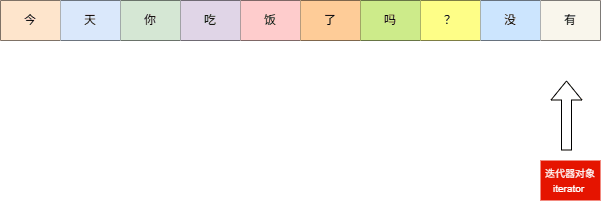
4.3.3.2 常用 API
- List 接口提供的获取 ListIterator 的方法:
| 方法 | 描述 |
|---|---|
ListIterator<E> listIterator(); | 获取列表迭代器对象,需要自己手动移动迭代器 |
ListIterator<E> listIterator(int index); | 根据索引获取列表迭代器对象,即:index = list.size() |
- listIterator 接口的常用方法:
| 方法 | 描述 |
|---|---|
boolean hasNext(); | 判断当前索引位置上是否有元素 |
E next(); | 获取元素,并向后移动迭代器对象(指针) |
boolean hasPrevious(); | 判断当前索引位置上是否有元素 |
E previous(); | 获取元素,并向前移动迭代器对象(指针) |
void add(E e); | 迭代遍历过程中,新增元素 |
void set(E e); | 迭代遍历过程中,修改元素 |
void remove(); | 迭代遍历过程中,删除元素 |
- 示例:
java
package com.github.collection;
import java.util.ArrayList;
import java.util.List;
import java.util.ListIterator;
public class Test {
public static void main(String[] args) {
// 创建集合
List<String> list = new ArrayList<>();
// 添加元素
list.add("aa");
list.add("bb");
list.add("cc");
list.add("dd");
list.add("ee");
list.add("aa");
list.add("bb");
// 打印集合中的元素
ListIterator<String> iterator = list.listIterator();
while (iterator.hasNext()) {
iterator.next();
}
while (iterator.hasPrevious()) {
String str = iterator.previous();
System.out.println(str);
}
}
}1
2
3
4
5
6
7
8
9
10
11
12
13
14
15
16
17
18
19
20
21
22
23
24
25
26
27
28
29
30
31
32
2
3
4
5
6
7
8
9
10
11
12
13
14
15
16
17
18
19
20
21
22
23
24
25
26
27
28
29
30
31
32
- 示例:
java
package com.github.collection;
import java.util.ArrayList;
import java.util.List;
import java.util.ListIterator;
public class Test {
public static void main(String[] args) {
// 创建集合
List<String> list = new ArrayList<>();
// 添加元素
list.add("aa");
list.add("bb");
list.add("cc");
list.add("dd");
list.add("ee");
list.add("aa");
list.add("bb");
// 打印集合中的元素
ListIterator<String> iterator = list.listIterator(list.size());
while (iterator.hasPrevious()) {
String str = iterator.previous();
System.out.println(str);
}
}
}1
2
3
4
5
6
7
8
9
10
11
12
13
14
15
16
17
18
19
20
21
22
23
24
25
26
27
28
2
3
4
5
6
7
8
9
10
11
12
13
14
15
16
17
18
19
20
21
22
23
24
25
26
27
28
第五章:常见的数据结构(⭐)
5.1 引入
数据结构是计算机存储数据和组织数据的方式。
提醒
数据结构在开发中非常常见,不同的场景我们采取不同的数据结构,会让数据的查找和存储更有效率。
- 如果数据比较多,我们可能会选择
哈希查找算法,如下所示:

- 如果数据量比较少,我们会直接使用
数组,如下所示:
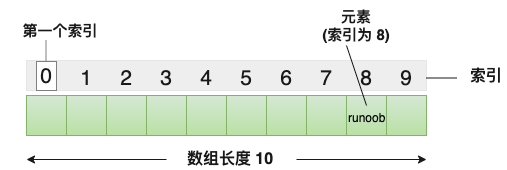
提醒
总结:不同的业务场景下,需要选择不同的数据结构。
- 在 List 接口下有 3 个实现类:ArrayList、LinkedList 以及 Vector,如下所示:
- 在这三个实现类中,Java 在底层采取了不同的数据结构。换言之,如果我们不会数据结构,我们根本不知道什么时候采用哪种集合。
5.2 概述
数据结构是计算机存储数据和组织数据的方式。数据结构是指数据相互之间以什么方式排列在一起的。数据结构是为了更加方便地管理数据和使用数据,需要结合具体的业务场景来选择。
提醒
- ① 一般情况下,精心选择的数据结构可以带来更高的运行效率或存储效率。
- ② 我们
暂时不需要学习如何手写各种数据结构,只需要把握以下三点即可:- 每种数据结构长什么样子?
- 如何添加数据?
- 如何删除数据?
- 我们暂时要学习的数据结构有:
栈、队列、数组、链表、二叉树、二叉查找树、平衡二叉树以及红黑树,如下所示:
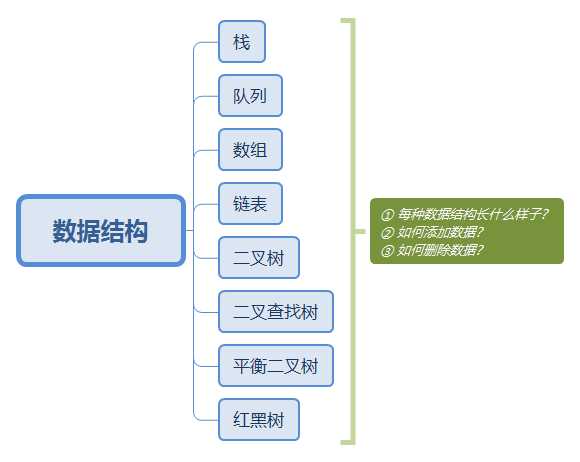
5.3 数据结构(栈)
5.3.1 概述
栈的特点:先进后出,后进先出。
5.3.2 演示
- 栈其实是一个容器,它用来存储数据的,这个容器是
一端开头,我们称之为栈顶,还有一端封闭,我们称之为栈底,如下所示:
- 假设现在有 4 个数据,那么它们是怎么存储到栈中,又是怎么从栈中取出的?
- 数据
进入栈模型的过程,我们称之为压栈(进栈、入栈),如下所示:
提醒
- ① 栈中最上面的元素,我们称之为栈顶元素。
- ② 栈中最下面的元素,我们称之为栈底元素。
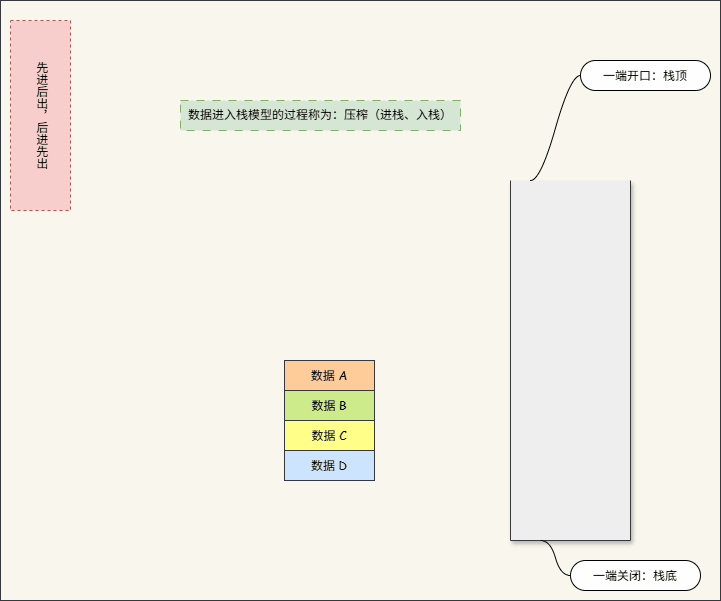
- 数据
离开栈模型的过程,我们称之为弹栈(出栈),如下所示:
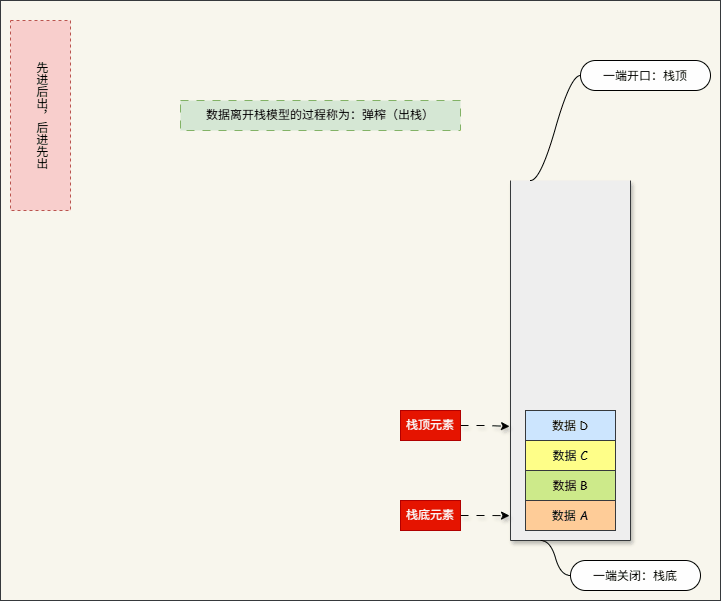
- 栈的完整动画,如下所示:
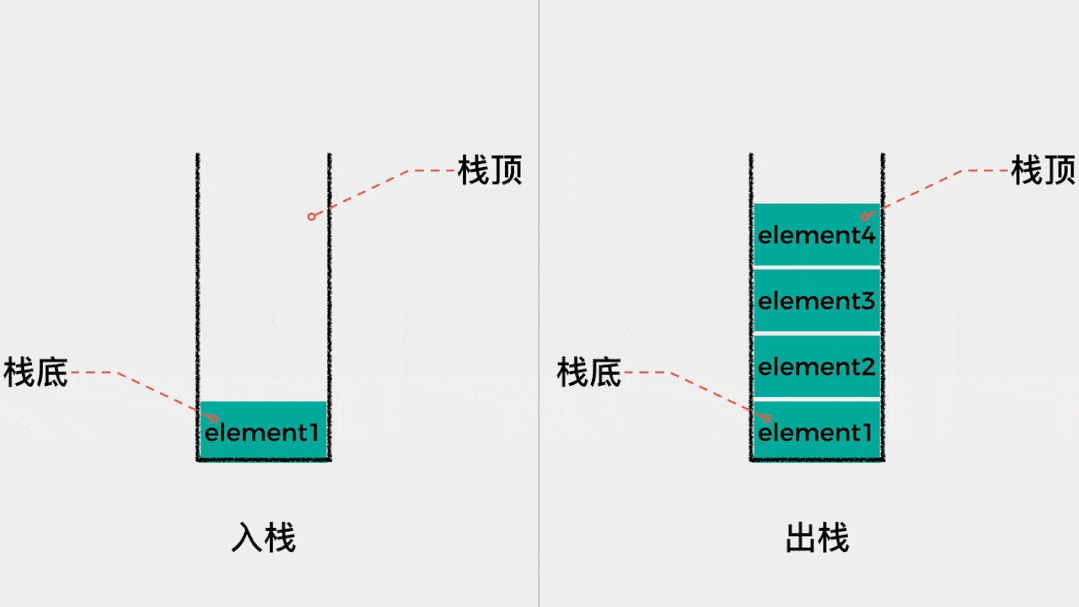
5.3.3 应用场景
- 在 Java 语言的内存结构中,有一块区域称为
栈内存,就是用的栈思想,如下所示:
提醒
- ① 方法调用的时候入栈。
- ② 方法调用完毕出栈。
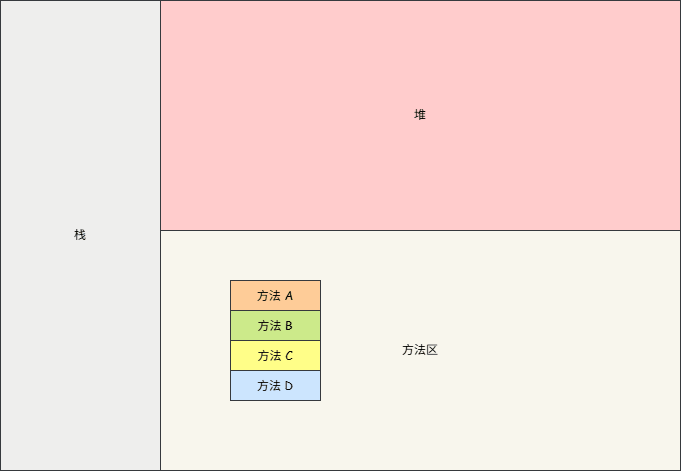
5.4 数据结构(队列)
5.4.1 概述
队列的特点:先进先出,后进后出。
5.4.2 演示
- 队列其实是一个容器,它用来存储数据的,这个容器是
两端开头,其中一端开头,我们称之为后端,另一端开头,我们称之为前端,如下所示:
- 假设现在有 4 个数据,那么它们是怎么存储到队列中,又是怎么从队列中取出的?
- 数据从后端
进入队列模型的过程,我们称之为入队列,如下所示:
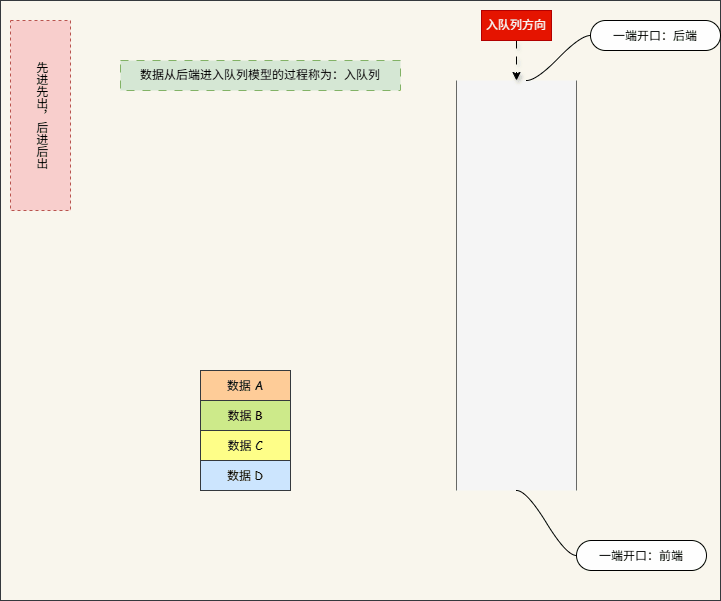
- 数据从前端
离开队列模型的过程,我们称之为出队列,如下所示:
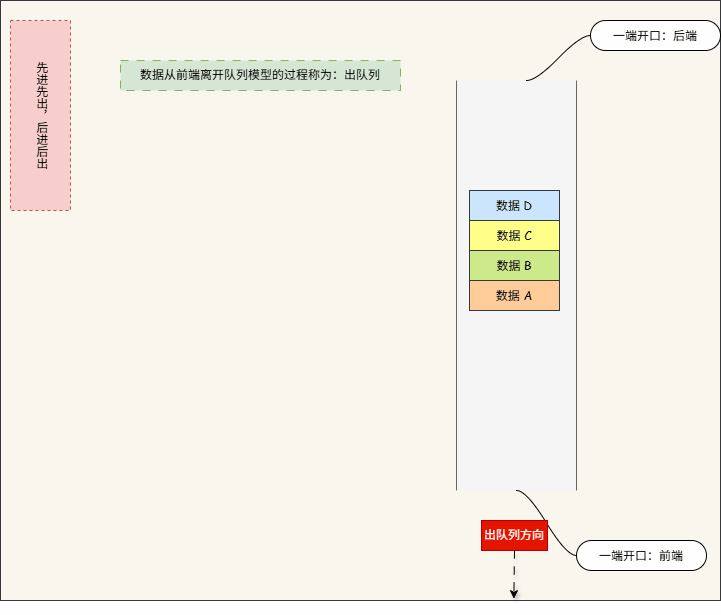
5.4.3 应用场景
- 现实生活中的
排队上公交等场景,应用了队列的思想,如下所示:

- 现实生活中的
排队买票等场景,应用了队列的思想,如下所示:

5.5 数据结构(数组)
5.5.1 概述
- 数组的特点:
查询速度快、删除效率低以及添加效率低。
5.5.2 演示
- 其中,
查询速度快指的是在数组中查询数据是通过地址值和索引进行元素定位的,查询任意数据消耗的时间是相同的。
提醒
数组中的元素在内存中是连续存储的。
- 其中,
删除效率低指的是要将原始数据删除,同时需要将后面的每个数据前移。

- 其中,
添加效率低指的是添加位置后的每个元素后移,再添加元素。

提醒
总结:数组是一种查询快、增删慢的数据模型。
5.6 数据结构(链表)
5.6.1 概述
- 链表的特点:
查询速度慢、删除效率快以及添加效率快。
5.6.2 专业术语
结点(节点,Node):链表中的每一个元素,我们称之为结点。
结点的存储位置(地址):每一个结点都是一个独立的对象,那么自身就会有一个地址值,表示结点在内存中的位置。
结点中保存的信息(具体的数据+下一个节点的地址值):结点中会保存具体的数据以及下一个节点的地址值。
头结点:在链表中第一个创建出来的结点。
添加新的结点:创建新的结点,并设置具体的数据,然后将该结点的地址保存到头结点中的地址属性中,依次类推,形成链表。
提醒
- ① 链表中的结点都是独立的对象,在内存中是不连续的,每个结点包含
数据值和下一个结点的地址。 - ② 链表的查询慢,无论查询哪个数据都需要从头开始查找。
- ③ 链表的增删相对较快。
5.6.3 演示
- 链表的查询慢,无论查询哪个数据都需要从头开始查找,如下所示:
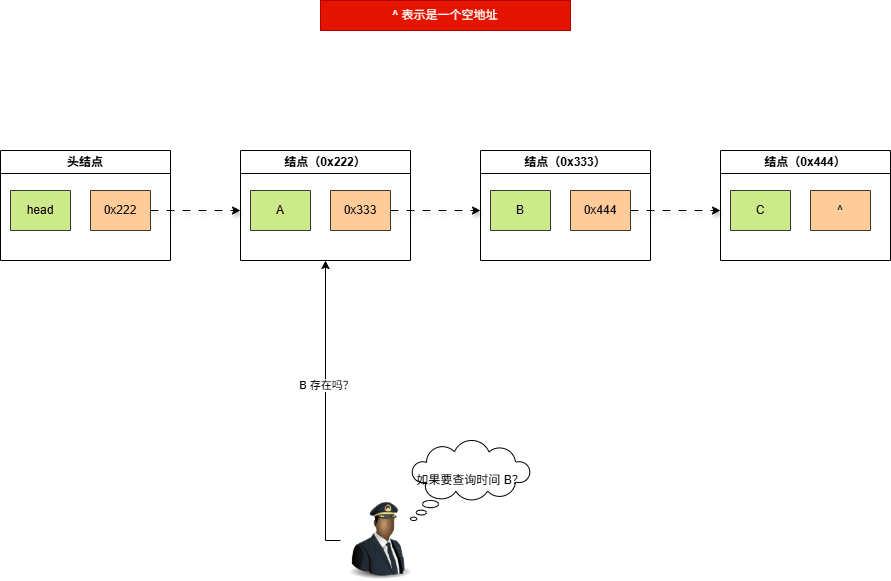
- 链表增加相对较快,如下所示:
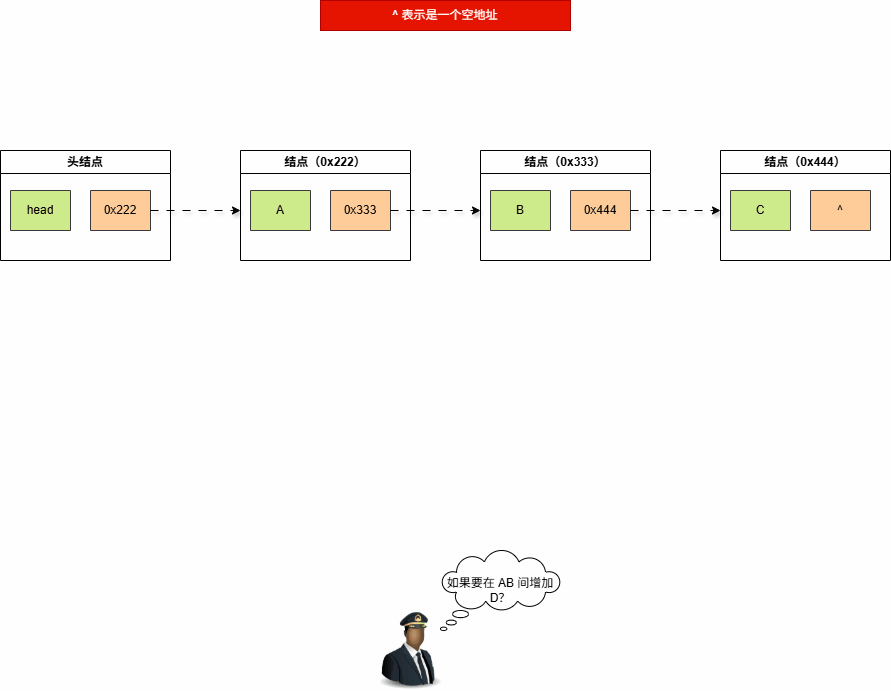
- 链表删除相对较快,如下所示:
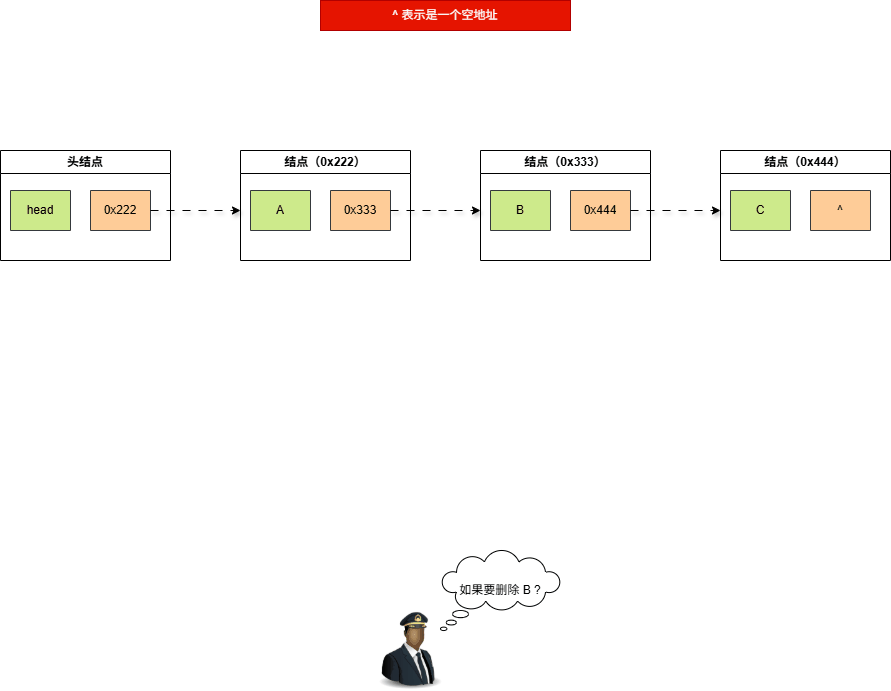
提醒
总结:链表是一种查询慢、增删快的数据模型。
第六章:底层源码分析
6.1 概述
- List 接口中最常用的子类是 ArrayList 和 LinkedList ,我们将仔细分析这两个类的底层源码。
6.2 ArrayList
6.2.1 概述
- ArrayList 满足基本 List 接口的特性:有序、重复、有索引。
- ArrayList 集合底层的实现原理是数组,大小可变。
- ArrayList 的特点:查询速度快、增删慢。
- ArrayList 是线程不安全的集合,运行速度快。
6.2.2 底层原理
- ① 利用空参创建的集合,其底层会创建一个默认长度为 0 的数组。
java
List<String> list = new ArrayList<>();1
- ② 当添加第一个元素的时候,底层会创建一个新的长度为 10 的数组。
java
list.add("a");
list.add("b");
...
list.add("j");1
2
3
4
2
3
4
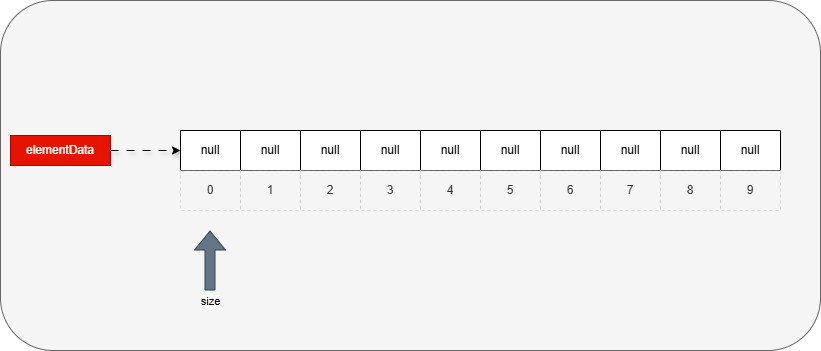
- ③ 如果数组已经存满,即:
size = elementData.length,此时就需要将数组进行扩容,扩容为原先的 1.5 倍,即:新数组的长度是 15 。
java
list.add("k");1
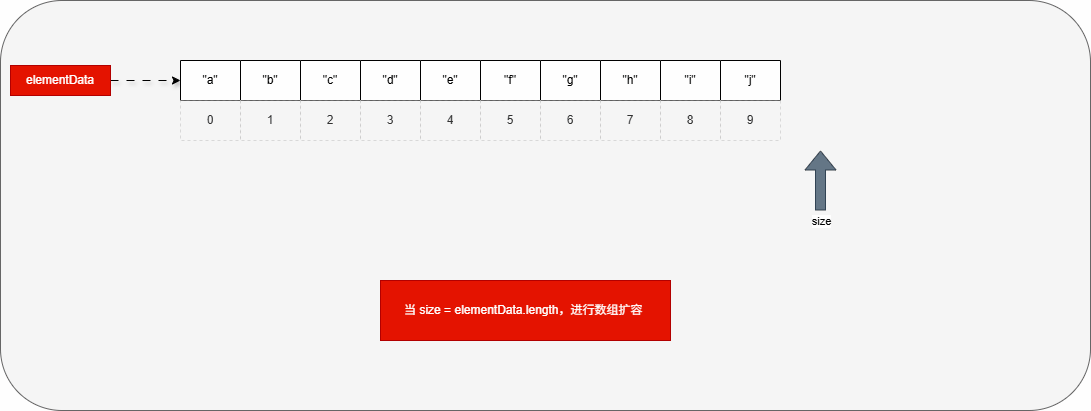
- ④ 如果一次添加多个元素,1.5 倍还放不下,则新创建数组的长度以实际为准。
6.2.3 源码分析
- ① 在 ArrayList 中添加第 1 个元素:

- ② 在 ArrayList 中添加第 11 个元素:
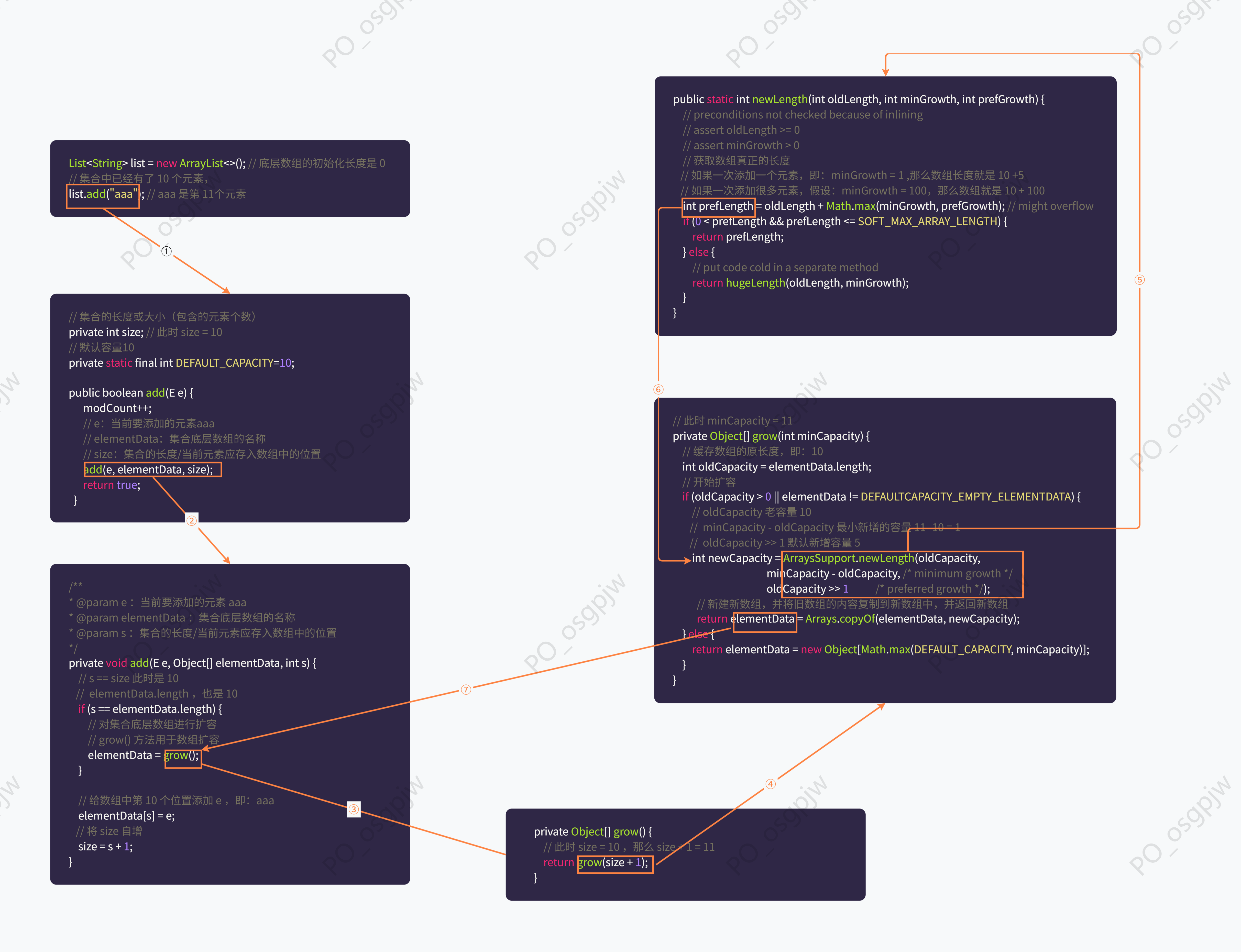
- ③ 在 ArrayList 中一次批量增加很多元素:
提醒
分为两种情况:
- ① 一次新增很多很多数据,如:
java
List<String> list = new ArrayList<>();
list.addAll(Arrays.asList("aaa", "bbb","",...,"zzz"));1
2
2
- ② 一次新增一个数据,但是突然新增很多很多数据,如:
java
List<String> list = new ArrayList<>();
list.add("a");
list.add("b");
...
list.addAll(Arrays.asList("aaa", "bbb","",...,"zzz"));1
2
3
4
5
2
3
4
5
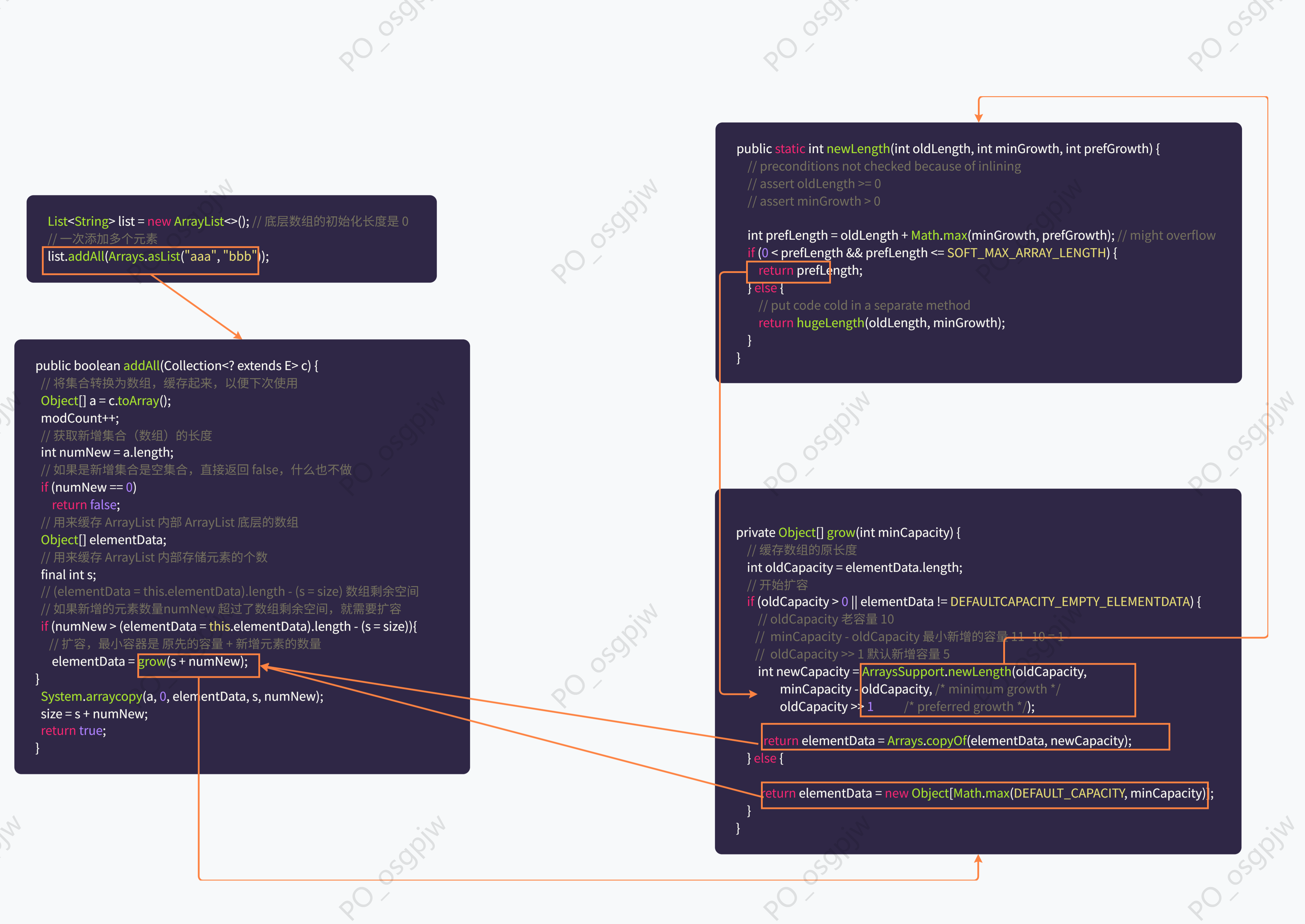
6.3 LinkedList
6.3.1 概述
- LinkedList 底层数据结构是双链表,查询慢,增删快;但是,如果要操作的是首尾元素,速度也是极快的。

- LinkedList 提供了很多直接操作首尾元素的特有 API:
| LinkedList 特有 API | 描述 |
|---|---|
| public void addFirst(E e) {} | 在列表开头插入指定的元素 |
| public void addLast(E e) {} | 在列表末尾追加指定的元素 |
| public E getFirst() {} | 返回列表中的第一个元素 |
| public E getLast() {} | 返回列表中的最后一个元素 |
| public E removeFirst() {} | 从列表中删除第一个元素并返回 |
| public E removeLast() {} | 从列表中删除最后一个元素并返回 |
提醒
在实际开发中,使用上述 API 的场景并不是很多,我们通常会使用 List 接口中的方法。